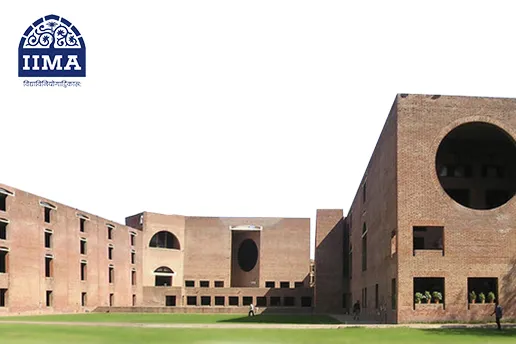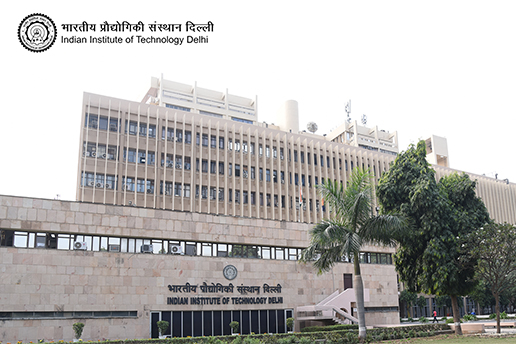VLSI Engineer: Career Paths & Opportunities
Table of Contents

Do you ever think about who designs the small chips that run your smartphone, laptop, smart TV, and even your car’s navigation? VLSI designers are behind all those technological advancements by developing integrated circuits that bring us closer to the digital world we live in. The semiconductor industry is predicted to surpass $1 trillion by 2030; thus, the need for VLSI engineers is booming.
But here’s the real question asked by students or professionals: Is VLSI a good career? The simple answer is yes! There are several roles in VLSI, such as designing microprocessors and embedded systems, that stem from the career path; it can lead you to some of the most progressive jobs in technology. In fact, entry-level VLSI engineers make a salary between ₹5.8 LPA as freshers, to ₹25–50 LPA as experienced engineers.
In this blog, let’s look into VLSI design, why it is important, and the top career options for prospective VLSI designers and engineers.
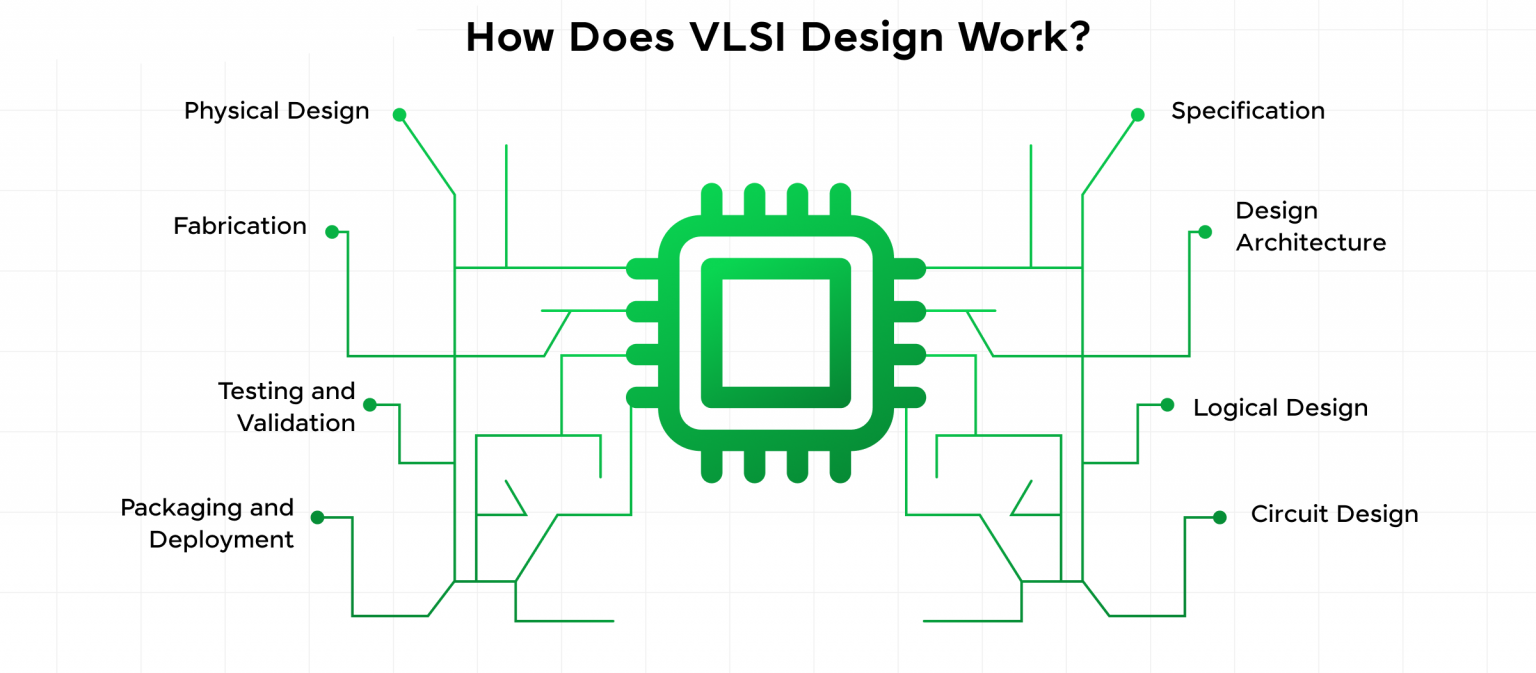
*guvi.in
What is VLSI Design?
VLSI (Very Large-Scale Integration) means integrating millions, even billions of transistors on a silicon chip. This technology changed electronics in the 70s, and it continues to power the digital world today. The design process is highly structured and consists of several abstraction levels:
- Functional architecture – specifying what the chip has to do.
- Register Transfer Level (RTL) – specifying how data flows and the logical operations.
- Logic design – implementing an architecture using logic gates.
- Circuit design – creating an electrical-level schematic.
- Physical design – converting schematics into manufacturable layouts.
Digital VLSI’s elegance is in the abstraction: complex systems are divided into small, quantifiable modules. This is how we can design everything from processors to memory chips are the engines that run our world.
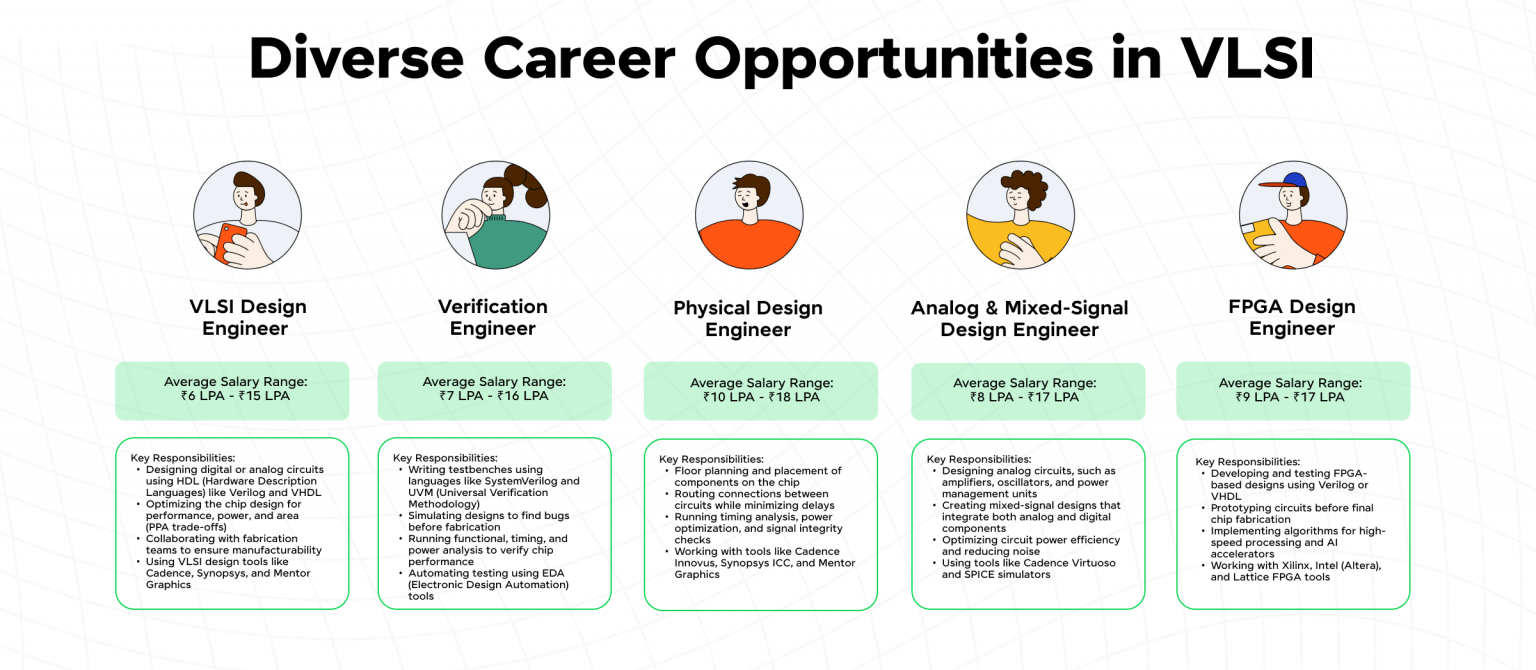
*guvi.in
Top 8 VLSI Design Job Roles
There is are pool of opportunities for a VLSI designer, including semiconductor manufacturing, aerospace, defence, and many more. These roles require experts who can not only design but also optimise integrated circuits while maintaining high performance. So, here are the top 8 VLSI designer roles that you need to know:
1. ASIC Design Engineer
Salary in India: ₹7–15 LPA (entry-level) to ₹60+ LPA (senior level).
An ASIC Design Engineer works on chips created for a specific purpose, like Artificial intelligence processors or smartphones. Unlike general processors, ASICs are optimised for speed, performance, and efficiency. This makes their role important in industries like telecom, automotive, and data centres. If you’re a VLSI designer who enjoys solving complex problems and pushing technology limits, this is one of the most rewarding jobs.
Key Responsibilities:
- Writing microarchitecture specifications
- Implementing RTL design using Verilog or VHDL
- Performing timing analysis and synthesis
- Ensuring low-power and high-performance chip design
2. FPGA Design Engineer
Salary in India: ₹6–12 LPA (entry) to ₹50+ LPA (senior).
FPGA engineers design reprogrammable chips that allow for flexibility even after manufacture. These job roles for a VLSI designer are highly in demand in various sectors such as aerospace, defence, and networking applications, where updates can happen in the blink of an eye. Thus, this role is ideal for those who are passionate about using digital VLSI design with the ability to adapt to real-world situations. As an FPGA engineer, you will work with high-speed systems, communication protocols, and more.
Key Responsibilities
- Develop RTL designs using Verilog or VHDL
- Test FPGA prototypes and debug
- Implement high-speed interfaces (PCIe, DDR, Ethernet)
3. VLSI Verification Engineer
Salary in India: ₹6–12 LPA (entry) to ₹50 LPA (senior).
Verification engineers in a VLSI designer category job role are those who are mainly responsible for seeing if a chip will work before the point of manufacturing it is manufactured. They build testbenches, run simulations, and find bugs as early as they can in the cycle.
If you love going into detail and live to debug problems, then this will be a good VLSI career path. Verification engineers will typically have one of the best growth opportunities, as every design will demand thorough verification.
Key Responsibilities:
- Creating testbenches using SystemVerilog and UVM
- Performing simulations to find design errors
- Debugging design errors before fabrication
4. Physical Design Engineer
Salary in India: ₹7–12 LPA (entry) to ₹40+ LPA (senior)
The physical design engineer transforms a logical circuit into a manufacturable layout on silicon. This is an important role for VLSI designers that requires them to mesh the world of design and manufacturing, but it is also full of details that require logic and foresight.
This role is ideal for a person who thrives on planning, power reduction, and timing closure in digital VLSI systems.
Key Responsibilities:
- Floorplanning and implementing logic block placement
- Clock tree synthesis and clock routing
- Timing closure and power closure
5. DFT (Design for Test) Engineer
Salary in India: ₹8–12 LPA (entry) to ₹50 LPA (senior)
A DFT Engineer guarantees that each chip produced is testable efficiently and effectively. DFT Engineers add testability features to the design for the purpose of detecting defective chips in production.
If you’re a VLSI designer who is passionate about working on straddling design and quality assurance, then a career in DFT would be ideal for you. In DFT, you will be a key contributor to the reliability and performance of chips found in billions of electronics.
Key Responsibilities:
- Implement scan chains, ATPG, and BIST techniques
- Ensure maximum test coverage
- Debug any test failure during production
6. Analogue/Mixed-Signal Design Engineer
Salary in India: ₹8–12 LPA (entry) to ₹50+ LPA (senior)
Analogue/Mixed-Signal engineers work with signals from the real world – sound, temperature, voltage, etc., and integrate them into digital systems. For example, they design circuits that are used in consumer electronic products, automotive systems, and IoT devices – amplifiers and oscillators.
If you’re a VLSI designer who wants to work on a circuit-level design and feel you can find a balance between creative design and detailed technical research, this VLSI career opportunity has exciting challenges and is a fast-growing area with a global demand.
Key Responsibilities
- Designing amplifiers, oscillators, and filters
- Integration of analogue and digital circuits on a single chip
- SPICE simulation and noise analysis
7. Semiconductor Process Engineer
Salary in India: ₹6–10 LPA (entry) to ₹25+ LPA (senior)
Process Engineers specialise in the fabrication side of VLSI. They develop and optimise processes that convert raw silicon wafers into sophisticated chips. Their responsibilities cover photolithography, etching, doping (ion implantation), and packaging.
As a VLSI designer, if you are interested in the science of chip manufacturing and want to work in a state-of-the-art facility, it offers opportunities for technical depth and to work globally.
Key Responsibilities:
- Developing and optimising fabrication processes
- Controlling the photolithography, ion implantation, and etching steps
- Ensuring yield and quality control.
8. Embedded Systems Engineer
Salary in India: ₹5–8 LPA (entry) to ₹35 LPA (senior)
Embedded engineers create systems that bridge hardware and software, such as IoT devices, automotive systems, and medical devices. Their work involves drafting firmware, developing microcontrollers, and ensuring devices operate effectively and safely in real-time.
This position is ideal for those VLSI designers who enjoy writing code while also wanting to remain close to hardware. As an embedded systems VLSI designer, you will help shape the technologies in smart devices that will define the future.
Key responsibilities:
- Drafting firmware in C/C++ or Python
- Integrating hardware with operating systems (RTOS, Linux)
- Debugging with oscilloscopes and analysers
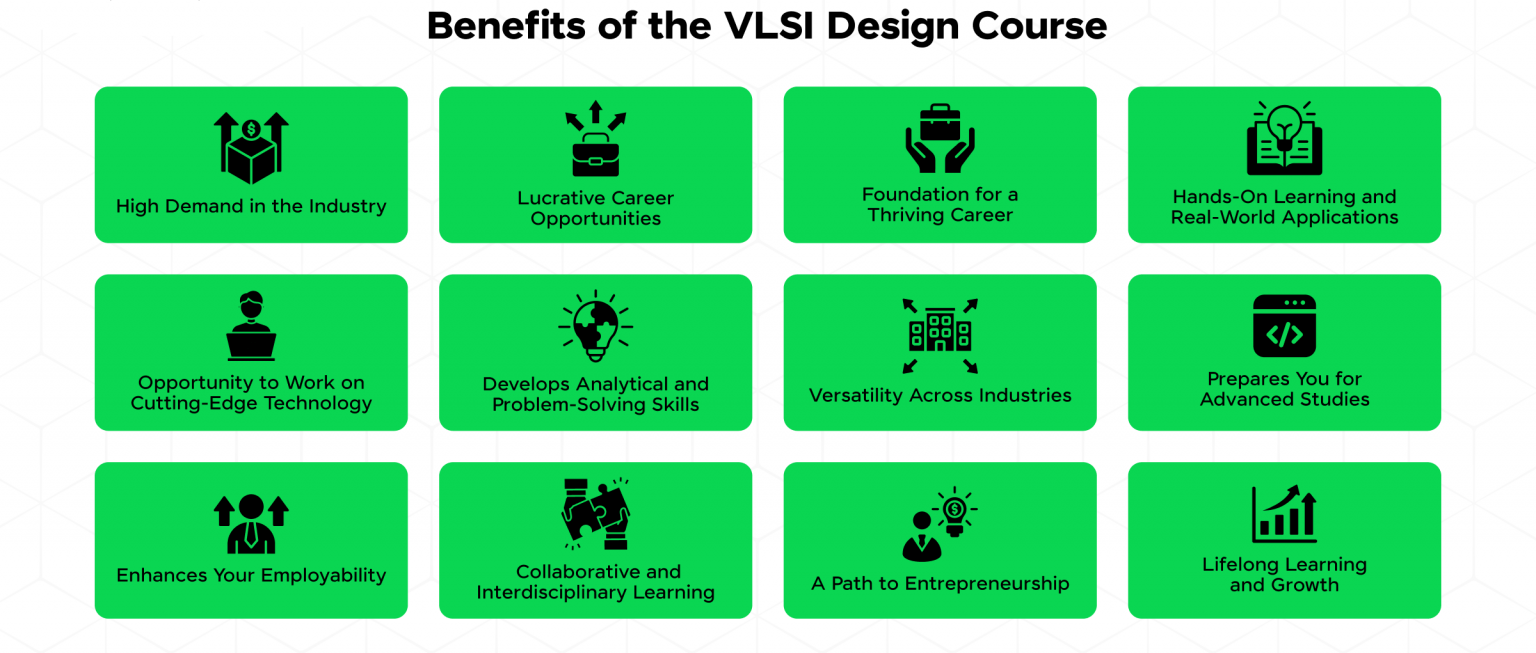
*guvi.in
Why Choose a VLSI Career?
Now, if you’re still wondering, “Is VLSI a good career?” Let’s show you some of the solid reasons that show why a career as a VLSI designer can be thriving:
1. Growth in the Industry
The semiconductor industry is increasing day by day, and due to the global chip shortage, every country is heavily investing in semiconductor manufacturing.
This growth creates immediate demand for a VLSI designer who can design, test, and modify chips and products that rely on chips. Chips are in every gadget from smartphones to electric vehicles, thereby providing long-term job security.
2. Varied Job Opportunities
Within the VLSI career path, you have a lot of choices and opportunities for exciting jobs. For example, an ASIC Design Engineer, FPGA Engineer, Verification Engineer, Physical Design Engineer, DFT engineer, Analogue Designer, and Embedded Systems Engineer.
Each job for a VLSI designer requires somewhat different skills, enabling you to focus on your interests. For example, you may prefer to work mainly with digital VLSI, chip test, or embedded.
3. Good Salaries and Rewards
Among the various positives of starting a career as a VLSI designer, salaries for new entrants are more than those of many traditional IT jobs. Salaries increase as professionals transition from entry-level to mid-level and then senior-level, upwards of ₹25–50 LPA in India, and globally, VLSI engineers are recognised among the highest-paid technology professionals.
4. Global Opportunities
Companies like Intel, AMD, Nvidia, Qualcomm, Broadcom, and TSMC hire VLSI engineers globally. These companies usually recruit from all over; not only in India, but Silicon Valley, Taiwan, Europe, and Japan.
This provides an opportunity for professionals to work internationally, travel, and work in technology hotspots across the globe.
5. Cutting-Edge Technology
A career as a VLSI designer is shaping the future of electronics technologies. You are going to work on chips for AI processors, 5G, IoT, electric vehicles, and space technologies.
Everything you work on will delight and impact millions of people globally. If you are interested in innovation and being part of technologically revolutionary changes, a career in VLSI is for you.
Final Thoughts
So, now you must have understood that VLSI is a good career choice. There are many jobs available across multiple companies where you can build a thriving future ahead. No matter if your interests lie in digital VLSI design, analogue systems, or semiconductor manufacturing, there is a job suitable for you.
Also, if you want to enter this trillion-dollar industry, get hands-on exposure and learn design methodologies by registering for the Certificate Programme in Digital VLSI Design Programme by CEP offered by IIT Delhi. This programme helps you learn all the industry-standard tools used in digital VLSI design, including CAD tools, hardware description languages (HDLs), and simulation tools. You can visit Jaro Education to enrol in this programme and also get unparalleled academic guidance and career counselling benefits.
Frequently Asked Questions
What are the key responsibilities of a VLSI Design Engineer?
A VLSI Designer is primarily responsible for designing and developing low-power and high-performance integrated circuits. They are also responsible for creating RTL designs using hardware descriptors and optimising circuits for different applications.
What is the salary of a VLSI Verification Engineer?
As we know, verification engineers are highly in demand as they ensure that the chip works smoothly. So a fresher’s salary ranges from ₹5–7 LPA, and a professional with 3–5 years of experience can get a salary ranging from₹10–15 LPA.
How to Increase Your VLSI Engineer Salary?
If you want to increase your VLSI designer salary, make sure to upskill yourself by enrolling in various online certification programmes and working on real-time projects to showcase your hands-on ability.
How are emerging technologies impacting VLSI design careers?
Advancements like AI, machine learning, and quantum computing are transforming VLSI designer careers, creating demand for expertise in ultra-low power designs, advanced chip packaging, and AI-driven methodologies, offering engineers new growth opportunities in cutting-edge semiconductor innovation.







![Journalism-and-Mass-Communication-Salary-in-India-in-2025-[Average-to-Highest]](https://jaro-website.s3.ap-south-1.amazonaws.com/2025/10/Journalism-and-Mass-Communication-Salary-in-India-in-2025-Average-to-Highest-1024x576.webp)

